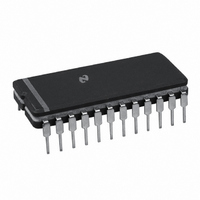ADC12451CIJ National Semiconductor, ADC12451CIJ Datasheet - Page 14

ADC12451CIJ
Manufacturer Part Number
ADC12451CIJ
Description
IC ADC 12BIT DYNAM TEST 24CDIP
Manufacturer
National Semiconductor
Datasheet
1.ADC12451CIJ.pdf
(18 pages)
Specifications of ADC12451CIJ
Number Of Bits
12
Sampling Rate (per Second)
83k
Data Interface
Parallel
Number Of Converters
2
Power Dissipation (max)
113mW
Voltage Supply Source
Analog and Digital, Dual ±
Operating Temperature
-40°C ~ 85°C
Mounting Type
Through Hole
Package / Case
24-CDIP (0.600", 15.24mm)
Lead Free Status / RoHS Status
Contains lead / RoHS non-compliant
Other names
*ADC12451CIJ
Available stocks
Company
Part Number
Manufacturer
Quantity
Price
3 0 Analog Considerations
In a ratiometric system the analog input voltage is propor-
tional to the voltage used for the A D reference When this
voltage is the system power supply the V
tied to V
of the system reference as the analog input and A D refer-
ence move together maintaining the same output code for a
given input condition
For absolute accuracy where the analog input varies be-
tween very specific voltage limits the reference pin can be
biased with a time and temperature stable voltage source
In general the magnitude of the reference voltage will re-
quire an initial adjustment to null out full-scale errors
3 2 ACQUISITION WINDOW
As shown in the timing diagrams there are three different
methods of starting a conversion each of which affects the
acquisition window and timing
With Auto-Zero high a conversion can be started with the
WR or S H controls In either method of starting a conver-
sion the rising edge of EOC signals the actual beginning of
the acquisition window At this time a voltage spike may be
noticed on the analog input of the ADC12451 whose ampli-
tude is dependent on the input voltage and the source re-
sistance The timing diagrams for these two methods of
starting a conversion do not show the acquisition window
starting at this time because the acquisition time (t
start after the conversion result high and low bytes have
been read This is necessary since activating and deactivat-
ing the digital outputs (DB0 DB7–DB8 DB12) causes cur-
rent fluctuations in the ADC12451’s internal DV
This generates digital noise which couples into the capaci-
tive ladder that stores the analog input voltage Therefore
the time interval between the rising edge of EOC and the
second read is inappropriate for analog input voltage acqui-
sition
When WR is used to start a conversion with AZ low the
Auto-Zero cycle is inserted before the acquisition window In
FIGURE 4a Low Drift Extremely Stable Reference Circuit
CC
This technique relaxes the stability requirement
REF
(Continued)
pin can be
CC
A
) must
lines
TL H 11025 – 20
14
this method the acquisition window is internally controlled
by the ADC12451 and lasts for approximately 7 clock peri-
ods Since the acquisition window needs to be at least
3 5
clock frequency is limited to 2 MHz The zero error with the
Auto-Zero cycle is production tested at a clock frequency of
1 75 MHz This accommodates easy switching between a
conversion with the Auto-Zero cycle (f
without (f
3 3 INPUT CURRENT
Because the input network of the ADC12451 is made up of
a switch and a network of capacitors a charging current will
flow into or out of (depending on the input voltage polarity)
of the analog input pin (V
sampling period The peak value of this current will depend
on the actual input voltage applied and the source resist-
ance
3 4 NOISE
The leads to the analog input pin should be kept as short as
possible to minimize input noise coupling Both noise and
undesired digital clock coupling to this input can cause er-
rors Input filtering can be used to reduce the effects of
these noise sources
FIGURE 5 Switching between a Conversion with and
s at all times when using Auto-Zero the maximum
without Auto-Zero when Using WR Control
CLK
Errors without any trims
Full Scale
Zero
Linearity
e
FIGURE 4b Simple Reference Circuit
3 5 MHz) as shown in Figure 5
IN
g
g
) on the start of the analog input
g
0 075%
0 024%
25 C
LSB
CLK
b
e
40 C to
1 75 MHz) and
g
g
g
TL H 11025 – 21
TL H 11025 – 22
0 024%
0 2%
LSB
a
85 C









